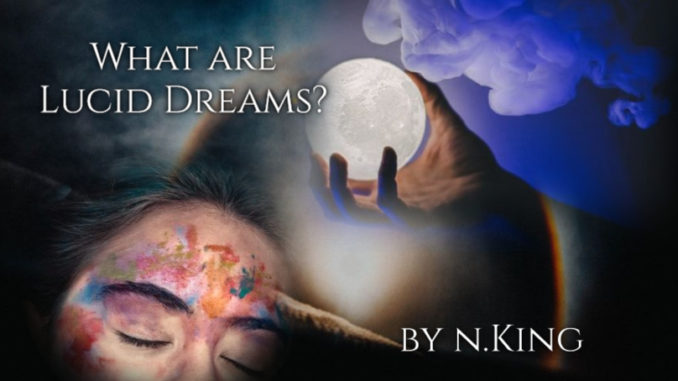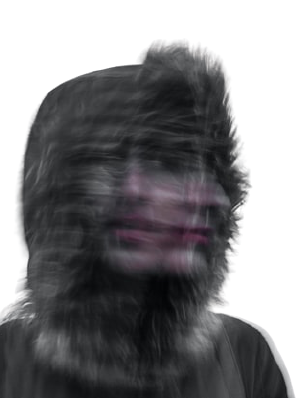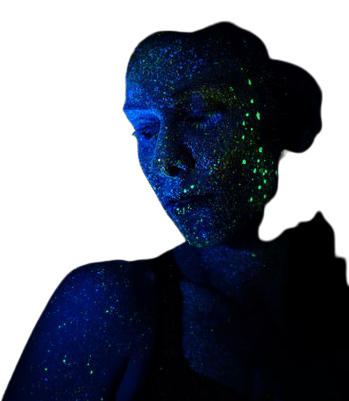
What are lucid dreams? As you read these words, imagine the letters blur. You look again and new words appear. This changeable form was my first sign of knowing that I was in a dream. I didn’t even know it was called a lucid dream.
In this dream, I looked down at my hand with great intent. Though my palm was detailed and clear, it also felt fluid. I then bounced off the ground and saw the houses far below me.
Before, I could explore the dream further, my excitement caused the dream to collapse. I woke.

What are lucid dreams?
Almost everyone has experienced at least one lucid dream. A lucid dream is when you know you are in a dream. You become conscious in the dream world. Therefore, it’s a very unique moment of the conscious mind meeting the unconscious self.
Here are 6 facts to help understand what lucid dreams are:
1. Lucid dreams were valued by many ancient cultures

Historically, lucid dreams were deeply explored in many traditional practices. Many Tibetan Buddhist monks were known as dream yogis and practiced lucid dreaming. There is even written evidence of this for about 5000 years.
In the west, the earliest known mention of lucid dreaming was by Aristotle – the Greek Philosopher.
Lucid dreaming was also valued in some practices of Sufism, Hinduism, and Shamanism. Furthermore, the Dalai Lama has even suggested that lucid dreaming is practice for the transition from this life to the next.
If dreams are unique to the individual, conscious exploration may help achieve divine wisdom.
2. There is scientific evidence of lucid dreaming

Keith Hearne and Stephen LaBerge scientifically proved the existence of lucid dreaming. Keith Hern, a psychologist , was the first researcher to conduct a successful lucid dream study.
In this dream study, a lucid dreamer was monitored in a sleep lab. When the dreamer reached a lucid dream state, the dreamer would signal his conscious awareness by moving his eyes from side to side. This specific eye movement was recorded on the REM polygraph paper. It provided hard evidence of a lucid dream.
La Berge, a Psychophysiologist, was the first to have this kind of study published in a science journal. La Berge also founded the Lucidity Institute that supports lucid dreaming research.
In the late 1980s, the research findings of LaBerge also began to draw more widespread interest in lucid dreaming. Subsequently, it seemed to have influenced mainstream culture through movies such as Avatar, Waking Life, The Matrix, and Inception.
Currently, the scientific community is paying more attention to lucid dreaming. The neurology, physiology, and beneficial applications of lucid dreaming is of particular interest.
3. Lucid dreaming has Clinical Therapy Applications

For about 20 years, Lucid dreaming therapy (LDT) has been used to successfully treat patients with frequent nightmares. The treatment involves training patients to lucid dream. As a result, the patients learn to consciously change their nightmares in a positive way.
Currently, clinical psychology is moving further in this direction. For example, lucid dreaming is now used to treat some patients with PTSD. During treatments, the patients relive the traumatic experiences through a lucid dream. With conscious intent, they learn to experience the trauma without fear.
This illustrates the value of lucid dreaming as a way to help the brain rewire itself in a beneficial way.
Dr. Dax Urbszat , a Professor of Psychology, at the University of Toronto, shared his thoughts through an online presentation entitled “Exploring the World through Lucid Dreaming.”
“ Lucid dreaming therapy makes me think about other future applications for exposure therapy such as for the treatment of phobias,” he said. ” I think we are going to start seeing a lot more research on the use of lucid dreaming.”
One medical study found that lucid dreaming may help relieve chronic pain. Dr. Mauro Zappaterra , a psychiatrist , conducted such a case study with her team. In conclusion, they were able to demonstrate a healing effect of lucid dreams. After 2 years of treatment, it helped bring relief to a chronic pain patient. Before treatment, the patient endured chronic pain for 22 years.
Those involved in this case study, held this as evidence of the power of the mind over the senses.

4. Lucid dreaming is not OBE (out-of-body experience)
There are many stories of people recalling an experience of floating above their bodies. This is known as an out-of-body experience (OBE). According to many reports, the experience is usually accompanied by a buzzing sensation or energy surge. However, this experience is not the same as lucid dreaming.
Firstly, it appears that most OBE reports trace to a childhood experience, trauma, or particular drug use. OBE’s seem to occur within a transition zone between wake and sleep.
On the other hand, lucid dreaming occurs within a dream state. From here, the dreamer gains awareness of the dream.
Secondly, during an OBE, it is believed that one cannot change the surroundings. However, during a lucid dream, the dreamer is able to change many aspects of the dream.
5. “Avatar” was inspired by lucid dreams

James Cameron , the director of “Avatar”, revealed that dreams inspired many movie ideas. For example, his lucid dream experiences even inspired the flying scenes in the movie.
In “Avatar”, a crippled man falls asleep and enters another realm of existence. In this other state of consciousness, he is able to walk, run and converse with characters of this world.
Similarly, this draws a parallel to the endless possibilities within dreams. For example, there is scientific evidence of patients, with spinal cord injuries , experiencing sensations in dreams that were not possible in real life.
In one study, the subjects all presented with a spinal cord injury that severed the connection between the brain and the lower body. In waking reality, they could not achieve an orgasm – among other inabilities. Yet, they were able to achieve the sensation of an orgasm in their dreams.

6. Lucid dreaming does not mean full control
Lucid dreaming is not the same as free reign over a fantasy world. Many lucid dreamers develop a deep respect for this inner space of exploration.
“I have used lucid dreaming for practicing martial arts and guitar. I even used it to practice my job talk – it got me my job at the University of Toronto,” shared Professor Dax Urbszat.
“ You don’t really control many aspects outside consciousness that contribute to the dream,” he adds. “I don’t like to call it dream control, I like to call it dream influence.”
Professor Urbszat has practiced lucid dreaming for over 30 years. He appreciates lucid dreaming as a way to explore adventure, problem solving, creativity, transcendence, skill enhancement and the study of consciousness.
Robert Waggoner, the author of “Lucid Dreaming”, compares the experience to sailing across an ocean. According to Waggoner, a lucid dreamer is like a sailor directing awareness within a larger state of dreaming and by extension – the Self.
In addition, Waggoner is also the president of the International Association for the Study of Dreams.
Like the hidden depths of the ocean waters, dreams appear to hold treasures of self-discovery. Above all, lucid dreaming holds another possible way to direct your path inward.
-By Nikita King
